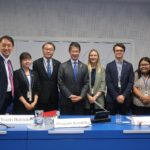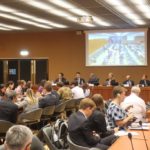(1) Formulation Committee members
(without titles, in alphabetical order)
 Yasushi Akashi (Committee Chairman)
Yasushi Akashi (Committee Chairman)Former Un Under-Secretary-General for Public Relations, Disarmament Affairs and Humanitarian Affairs; Chairman of the International House of Japan
The 20th century was a bloody century, and this century confronts disorderly transnational economic activities and environmental destruction.
Hiroshima is a place where effective debate and action can take place for peace-building and disarmament – nuclear and conventional.
 Nobuyasu Abe
Nobuyasu AbeFormer Un Under-Secretary-General for Disarmament Affairs, Director of the Center for the Promotion of Disarmament and Non-Proliferation at the Japan Institute of International Affairs
I have been involved in the formulation of the “Hiroshima for Global Peace”Plan. In spite of all the efforts to attain nuclear abolition and international peace in such fora as the United Nations, NPT and Pugwash Conferences, we have not yet gained a sure perspective for their realization. Thus, I sincerely hope that Hiroshima can serve as an international hub to muster the wisdom from around the world to attain those goals. I will make my best efforts to this end.
 Yoriko Kawaguchi
Yoriko KawaguchiFormer Japanese Minister of Foreign Affairs, Member of the House of Councilors
What I find remarkable about the “Hiroshima for Global Peace”Plan is the strong emphasis the initiative places on education in its efforts to expand its range of activities from nuclear arms reduction to peacebuilding. In this day and age where anyone can easily access information from around the world, there is a renewed focus on the powerful potential for advocacy that Hiroshima, the “site of peace”, inherently possesses. The first step towards success is to get as many people as possible to visit Hiroshima. I firmly believe Gov. Yuzaki’s confident actions will lead to great results.
 Gareth Evans
Gareth EvansFormer Australian Minister of Foreign Affairs, Chancellor of the Australian National University
Visiting Hiroshima as a young student changed my life: making me understand, as nothing else could, that nuclear weapons are the most indiscriminately inhumane weapons ever conceived and must be outlawed. The “Hiroshima for Global Peace”Plan – with its articulate statement of challenges, detailed action proposals, and plan to further develop Hiroshima as a global support hub for worldwide peace – has the potential not just to change many more young lives, but to save from destruction life on this planet as we know it.
 G. John Ikenberry
G. John IkenberryProfessor at Princeton University, U.S
Hiroshima occupies a special place in world history as a symbol of both the destructiveness of war and the promise of world peace. It is heartening, therefore, that Hiroshima has stepped forward with a bold new vision – the “Hiroshima for Global Peace”Plan – designed to help move the world toward nuclear disarmament and conflict resolution. It is a vision in which Hiroshima becomes a global hub for international dialogue, public education, and research. It is a vision that seeks to move the negotiations over nuclear arms control and disarmament into new multilateral venues in which non-nuclear states can play a constructive role. It is a vision that seeks to link global disarmament to the tackling of specific issues of regional security, in East Asia and around the world. It is a vision that also connects nuclear disarmament to the wider agenda of conflict reduction and peace building within and among troubled and war ravaged societies.
 Scott D. Sagan
Scott D. SaganProfessor at Stanford University, U.S
Even a brief visit to Hiroshima provides a vivid reminder about the horrors of nuclear war. The “Hiroshima for Global Peace”Plan is designed to bring global scholars, diplomats, leaders and citizens to Hiroshima to inspire continued work on nuclear nonproliferation, disarmament, and conflict resolution. The nuclear arsenals of the world today contain thousands of nuclear weapons, each one of which could destroy a city. We must seek a safer way to protect our nations and preserve the peace.

Kiichi Fujiwara
Professor at the Graduate Schools for Law and Politics, the University of Tokyo
Nuclear weapons cannot be abolished so long as governments rely on nuclear capability for their security. Here we must connect the idea of nuclear abolishment with actual policy designs that assure security without nuclear arms. The Hiroshima project is one attempt for that purpose, where the idea of nuclear disarmament accompanies actual process of tension reduction in international conflicts, so that future generation may live in a nuclear-free world with stable peace.
Hidehiko Yuzaki
Governor of Hiroshima Prefecture
(2)Task Force
1)Task Force members
(without titles, in alphabetical order)

Nobumasa Akiyama
Associate Professor at the School of International and Public Policy, Hitotsubashi University
I believe it is extremely praiseworthy that Hiroshima Prefecture, through this new Plan, is taking a fresh approach in the areas of nuclear abolition and post-conflict reconstruction, for the ultimate goal of achieving global peace. It is my hope that in addition to working with the City of Hiroshima in conventional undertakings, the Prefecture will help achieve a world free of nuclear weapons more rapidly by actively lobbying the international community and willingly engaging in the nuclear abolition movement. I am honored to be part of this project and at the same time feel the weight of my responsibilities to Hiroshima as well as the global society.

Yuji Uesugi
Associate Professor at the Graduate School for International Development and Cooperation, Hiroshima University
To date, numerous discussions have been held and many proposals have been raised.
Firm political resolve and commitment are essential for creating a program of concrete actions toward the success of this endeavor.
The time has come to move steadfastly forward under the leadership of Gov. Yuzaki to achieve the Plan.
Although my role in the larger scheme of things may be small, I will work as hard as possible to bring this initiative to fruition.
 Noriko Sado
Noriko SadoAssociate Professor at the Faculty of Law, Hiroshima Shudo University
The passionate desire for peace lying in the hearts of the people of Hiroshima must be translated into measures that lead to specific results. Moreover, if Hiroshima submits concrete proposals and actions the international community will surely acknowledge that we are trying to fulfill our obligations toward global peace. The “Hiroshima for Global Peace”Plan presents issues the people of Hiroshima must contemplate and actions they must take. I hope this initiative will become an impetus for each and every one of us who live in Hiroshima to take action in order to transform this region into an even more vibrant base for the advocacy of global peace.

Kazumi Mizumoto
Vice-President of the Hiroshima Peace Institute, Hiroshima City University
On the one hand, although Hiroshima was decimated by a nuclear weapon, the region managed to recover through cumulative efforts to rebuild a peaceful society. On the other hand, throughout history virtually all nations and races of this world have been deprived of peace in one way or another and then experienced the painful road to recovery. the “Hiroshima for Global Peace”Plan aims to encourage Hiroshima to work together with the people of the world to consider and promote ideas, however trivial they may seem, to achieve peace.
Nobuyasu Abe (Formulation Committee member)
Kiichi Fujiwara (Team Leader/ Formulation Committee member)
G. John Ikenberry(Formulation Committee member)
Scott D. Sagan (Formulation Committee member)
2)Advisors
(without titles, in alphabetical order)

Alexander A. Mejia
Head of the UnITAR Hiroshima Office
On behalf of the United Nations Organization and specifically of UnITAR, I would like to congratulate the Hiroshima Prefecture on launching the visionary “Hiroshima for Global Peace”Plan. It is our great honor to work closely together with the Prefecture in the implementation of this historic initiative, conceived to enhance Hiroshima’s contribution to nuclear disarmament. I believe this Plan will tangibly strengthen the process of post-conflict reconstruction and peace-building that the Hiroshima Prefecture is supporting in countries like Afghanistan and Iraq. We are fully committed to supporting the Governor of Hiroshima and his team in the implementation of this unique and strategic road map towards global peace.

Nassrine Azimi
Senior Advisor to the Executive Director, United Nations Institute for Training and Research (UnITAR)
Foreign visitors to Hiroshima are often inspired, by how deeply ingrained in the people are the guiding principles of Hiroshima’s resurrection after the Atomic bombing of 1945: ‘To forgive but not to forget’, ‘Never again (to nuclear weapons)’, and finally ‘Transformation from a military city to one devoted to peace’. Thus since the end of Wwii Hiroshima has come to represent in the eyes of the world, human folly and tragedy, but also human resilience and courage – a constant reminder of a nuclear path never to be taken again. Having had the privilege of working with Hiroshima for more than a decade, I, too, feel deeply its significance for us all, and for this fragile, beautiful, blue planet of ours. Hiroshima’s message is Peace — in its most humanistic and universal expression.

Noriaki Nishimiya
Director General of the JICA Chugoku International Center
I would like to appreciate this initiative the “Hiroshima for Global Peace”Plan by Hiroshima Prefecture and effort spent by the experts concerned in terms of the present world situation. JICA has implemented a lot of factual peace building projects and obtained lessens in conflict affected countries or areas. Through strength of an implementation agency and project experience, JICA will cooperate in making action plans for promoting this initiative with other related organizations.
 Yasushi Akashi (Committee Chairman)
Yasushi Akashi (Committee Chairman) Nobuyasu Abe
Nobuyasu Abe Yoriko Kawaguchi
Yoriko Kawaguchi Gareth Evans
Gareth Evans G. John Ikenberry
G. John Ikenberry Scott D. Sagan
Scott D. Sagan


 Noriko Sado
Noriko Sado










